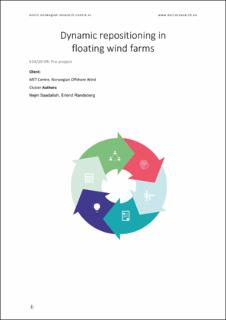| dc.description.abstract | The potential for harvesting Norwegian offshore wind power resourcesis undoubtably tremendous, however, currently limited by the cost of energy especially at deep waters. A general challenge for wind power production is the so-called wake effect, in which up-wind turbines shadow downstream neighbours. When moving into the domain of floating offshore wind power, the fact that turbines are not fixed to the seafloor may open new opportunities. Specifically, the ability of moving downstream turbines out of detrimental wakes may allow for higher energy output than for fixed turbines with the same spacing.
Simulation studies described in the literature suggest that horizontal repositioning of floating wind turbines as the wind direction changes could be an attractive option to increase the power output. In the present study, simple simulations using readily available tools confirm this. Further, the potential gain of vertically displacing individual turbines has been investigated in current simulations, complementary to other studies in the literature only considering horizontal repositioning.
The current study has been organized in three main activities. First, an initial study with simple simulations and engineering type wake models has been performed. In this, the possible energy gains of horizontal and vertical repositioning of downstream turbines has been evaluated. Through this, rough estimates were found regarding order of magnitude of movement required to achieve significant energy gains, both through simplified two-turbine configurations and more realistic wind park scenarios.
Second, a concept evaluation was done to identify main challenges and options relevant for implementation of the dynamic repositioning. Different floating wind turbine concepts were considered regarding horizontal and vertical movability, control mechanisms to enable displacement, mooring/anchoring requirements, cabling etc. The evaluation also included an assessment of existing simulation models for wind field description and energy production, including turbine interactions, and dynamic properties such as turbulence intensity and its impact on structural loading/fatigue. When introducing the additional degree of freedom of varying turbine position, there is a clear need to deploy simulation tools that can accurately capture the wind field dynamics and at the same time be sufficiently fast for frequent wind field updates.
The third activity has been on defining a full research project to bring the concept closer to industrial realization. This includes description of state of the art, project contents and organization. In the proposed project, the focus is on modelling of the wind field and turbine dynamics, development of optimization tools and methods for assessment of cost/benefit, and establishing software tools for case studies and concept evaluation.
It is believed that there is a great potential of the proposed concept of dynamic repositioning the floating wind turbines relative to each other, but there is clearly a need to bring this a step further through in-depth studies, development of new methods and qualification of technical and economic implications. | |
